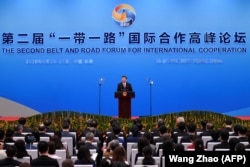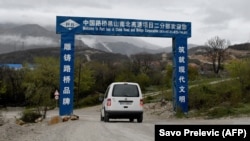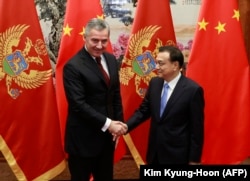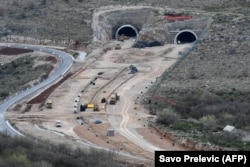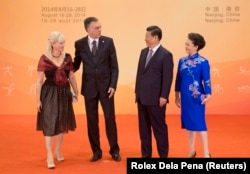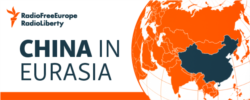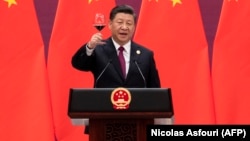
Over the last decade, China has rapidly expanded its financial presence across the globe.
It has issued massive loans through its flagship foreign policy project, the Belt and Road Initiative. It has inked contracts with governments from Latin America to Africa and Eastern Europe to South Asia.
But despite being the world's largest official creditor, many of the basic facts around Beijing's foreign lending are still unknown.
Crucial details about the terms and conditions of China and its state-owned entities' development and infrastructure loans in such places are still murky. Few of those contracts between foreign governments and Chinese lenders have been made public.
But a recent study by the Center for Global Development, a Washington-based think tank, aims to pull the curtain back on Chinese lending practices by offering a first-of-its-kind analysis of 100 contracts across 24 developing countries in Africa, Asia, Europe, and Latin America, including Montenegro, Kyrgyzstan, and Serbia.
“China is the top lender in the world, so it matters how it approaches these contracts,” Scott Morris, a senior fellow at the Center for Global Development and one of the report’s authors, told RFE/RL.
“What we see is a unique set of restrictions alongside other provisions in contracts that contribute to China being a muscular lender that can strengthen its position vis-a-vis the borrowing country,” Morris added. “Generally, there is a lack of transparency across the board and wide-ranging terms that make sure China can protect its investments.”
Unsustainable debt and the constrictive terms of Chinese loans have come under increased scrutiny in recent years as more governments have signed deals with China’s state-owned lenders. Concerns have particularly focused on some clauses that allow Chinese entities to seize property or assets when payments can’t be met, prompting fears of land or other assets being taken and massive debts leaving governments beholden to Beijing.
Such worries flared up again in April after Montenegro’s government said that it needs help from the European Union to pay off a $1 billion Chinese loan for a controversial highway project.
Similarly, Kyrgyzstan is also grappling with how to pay back the $1.8 billion -- more than 40 percent of its foreign debt -- it owes to Chinese lenders as repayment dates draw closer and it faces financial hurdles brought on by the pandemic.
'A Muscular Lender'
The Center for Global Development report, which was released in late March, was produced in collaboration with AidData, a research lab at the College of William and Mary, to break down shared features of Chinese debt contracts and how they compare to lending practices by other multilateral or commercial creditors.
The study looked at contracts signed around the world with China’s two main state-backed lenders, the Export-Import Bank of China and the China Development Bank.
The authors were able to identify three key features: a reliance on secrecy clauses to keep borrowing governments from revealing the details of their debt; terms meant to keep Chinese debt out of collective restructuring; and clauses allowing for the cancellation of debt or accelerated repayments, which could potentially influence the policies of debtor countries.
The Chinese government has largely resisted efforts to reveal the full scope of its global lending program around the world. Beijing is part of neither the Organization for Economic Cooperation and Development's (OECD) Creditor Reporting System nor its Export Credit Group, which are designed to create more transparency around the loan process.
China also is not a member of the Paris Club, a group of creditor nations created more than half a century ago to help countries experiencing payment difficulties with their debt.
More recently, Beijing committed to the G20 Common Framework among G20 and Paris Club members in 2020, extending debt relief to developing countries worth a combined $2.1 billion, perhaps signaling a shift on the issue.
Still, much of Chinese lending remains shrouded in secrecy.
According to the Center for Global Development study, all of the China Development Bank contracts and 43 percent of the Export-Import Bank of China deals seen by the authors included confidentiality clauses about the terms of the loans.
While the authors note that confidentiality is a feature in many loans, the Chinese contracts flip standard practice on its head -- committing the borrowing government, rather than the lender, to nondisclosure.
Similarly, the Chinese deals are far more sweeping in their secrecy, covering all details of the loan and even the existence of debt itself in some cases.
“Commercial confidentiality is meant to protect the borrower because they need to give the creditor access to lots of sensitive information,” Morris said. “But the Chinese confidentiality provisions put a much higher value on secrecy and tend to protect the lender.”
Subscribe To Our New China Newsletter
It's impossible to tell the biggest stories shaping Eurasia without considering China’s resurgent influence.
China In Eurasia is a newsletter by correspondent Reid Standish in which he builds on local reporting from RFE/RL’s journalists to give you unique insights into Beijing’s ambitions. It's sent on the first and third Wednesdays of each month.
To subscribe, click here.
Another unique aspect of the Chinese loans is what the report refers to as “no Paris Club” clauses, which prevent a borrowing government from restructuring a loan from a Chinese entity elsewhere or seeking debt relief from another source.
Finally, the report cautions about the prevalence of clauses that allow Chinese creditors to cancel a contract or demand immediate repayment in case of major changes to the law or policy within the borrowing country.
While such provisions are normally used by lending institutions around the world to protect against changes that could prevent repayment, the study finds that Chinese contracts use a more ambiguous definition that could allow the creditor to politically pressure an indebted government.
“The terms are so broadly written that it could cover any change of policy or law that would affect the relationship,” Morris said. “If the state-owned creditor becomes unhappy with the government, it can call in the loan early, cancel it, or change the repayment schedule. It provides many levers for influence.”
Debt Traps Or Playing A Different Game?
The motives for such provision in contracts issued by China’s state-owned lenders has been a source of much debate.
Critics argue that they amount to a “debt trap” deliberately set by Beijing in order to saddle a country with debt and thereby increase its influence and control over that government.
Accusations of such practices resurfaced in the case of Montenegro’s highway debt to China, which stems from a 2014 loan under a previous government in Podgorica.
The Montenegrin government that came to power last year has warned of the dependency on China that the massive loan could create, and some European officials have echoed those concerns. The terms of the contract, which was signed with the Export-Import Bank of China, could allow that bank to take control of the highway or seize other assets, although there is no indication that the Chinese bank intends to do so.
Having examined the Montenegrin contract and other Chinese deals around the world, Morris said that they don’t appear to point toward Beijing deliberately lending in order to draw countries into unsustainable debt situations.
“The obligations they place on the borrowing governments are extraordinary compared to other lenders,” Morris said. “But a general conclusion after looking at the contracts is that Chinese entities are issuing loans with the full intention of getting their money back.”
In the case of Montenegro, the European Union rebuffed Podgorica's call for assistance to repay the loan, but Brussels has also indicated it will search for other ways to help the EU candidate country.
According to Morris, the nature of the contract limits the options that Montenegro can pursue elsewhere. And while he does not rule out the possibility of Beijing offering some form of debt deferment or restructuring, the design of the contract ensures that China will have at least a voice in whatever solution is reached.
“Any relief [Montenegro] is seeking will need to come from the Chinese and be agreed upon with them,” Morris said. “There is not a path forward that can ignore the Chinese.”








